El Dorado › El Tajin › Pizarro & the Fall of the Inca Empire » Origins and History
Articles and Definitions › Contents
- El Dorado › Antique Origins
- El Tajin › Ancient History
- Pizarro & the Fall of the Inca Empire › Who Was?
Ancient civilizations › Historical places, and their characters
El Dorado › Antique Origins
Definition and Origins
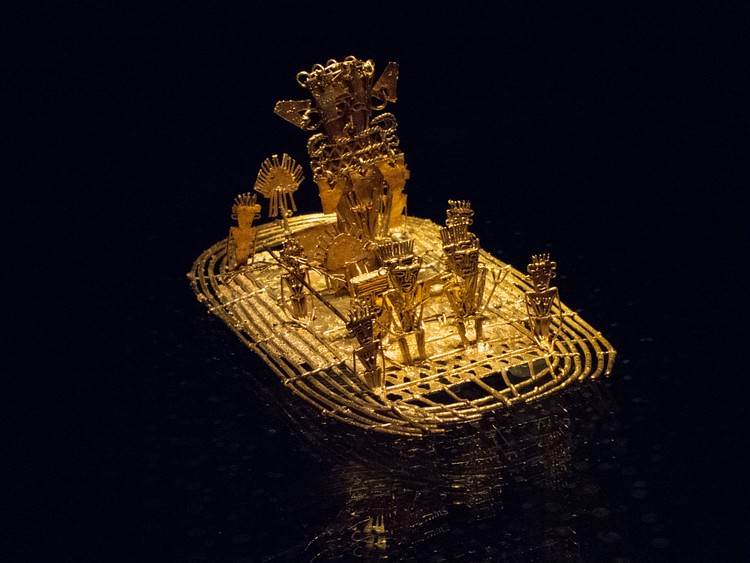
El Dorado ('Gilded Man' or 'Golden One') referred to the legendary kings of the Muisca (or Chibcha ) people who populated the northern Andes of modern-day Colombia from 600 CE to 1600 CE and the name is especially associated with their coronation ritual held at Lake Guatavita, just north of modern-day Bogotá. Over time, El Dorado extended its meaning to refer to a lost golden city and even an entire region. When the Spanish Conquistadors heard these incredible tales of a city paved in gold they tried every means possible to find it. Ultimately though, the Spanish, and the explorers and treasure hunters who followed them, never did find the fabulous treasures of El Dorado.
THE SIGNIFICANCE OF GOLD
In the cultures of ancient Colombia gold had long been a popular material for metalworkers. The metal actually had no particular value as currency other than as a raw material for exchange and, indeed, it seems that, unlike in other Americas cultures, gold was not limited to the nobility but also owned by lower stratas of society. Rather than its intrinsic value, then, gold was esteemed because of its lustre, incorruptibility, spiritual associations (especially concerning the sun), and workability in the hands of craftsmen. Skilled Muisca artisans produced stunning works of art using the full range of the goldsmith's repertoire, especially the lost-wax technique.
Gold and gold alloy artworks were offered in vast quantities to the gods and buried at sacred locations so that the balance of the cosmos was maintained and natural disasters averted. Very often the offerings were figurines known as tunjos which represented in fine detail people carrying objects such as shields, weapons and musical instruments. The most famous example of a tunjo is a golden raft with cast figures wearing jewellery standing upon it, the significance of which is discussed below. The raft was found in a clay vessel inside a cave and it now resides in the Museo del Oro in Bogotá.
THE MUISCA ESTEEMED GOLD BECAUSE OF ITS LUSTRE, INCORRUPTIBILITY AND ASSOCIATION WITH THE SUN.
So driven were they by their thirst for riches, the official Spanish government objective of exploration in northern South America was, in fact, to find gold, melt it down and ship as large a quantity as possible back to Europe. The association between ancient Colombia and the precious metal is further reflected in the Spanish King's choice of name for his new territory: Castillo del Oro. Of all the stories of gold and emeralds scattered across ancient Colombia there was one particular tale which especially aroused the interest of the Spanish invaders. This was an account, reported by eye-witnesses, which involved the lavish ceremonies performed during the coronation of a Muisca king.
THE GILDED MAN
The legend of El Dorado appears in most Spanish accounts of the region's conquest such as Fernández de Oviedo's Historia general y natural de las Indias (1535-48 CE) but was later documented in greatest detail by Juan Rodriguez Freyle in 1636 CE, who claimed to have been told the details by the nephew of the last ruler of Guatavita. One of the oldest representations of the legend in art comes from an engraving of 1599 CE by Theodor de Bry which shows two attendants applying gold to the body of a third individual.
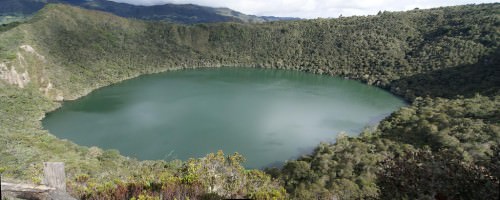
Lake Guatavita, Colombia
According to the legend, then, amongst the Muisca, when it was necessary to crown a new monarch, the man who would be king prepared for his great day with a period of abstinence. Secluded in a cave, he was forbidden chilli peppers, salt and women. When the coronation day finally arrived the future king travelled to Lake Guatavita, a remote lake formed in an extinct volcanic crater, in order to give offerings to the gods so that they might bless his reign. This he did by going to the centre of the lake on a raft. The raft, made from reeds, was laden with treasures of gold and emeralds and on it were placed four large incense burners. The incense was moque and the braziers, joined by those set around the shores of the lake, gave off clouds of thick smoke which must only have added to the mystique of the ceremony.
The most fantastic treasure of all, though, was the royal person himself. He had been stripped naked and entirely covered in a sticky layer of resin on which was blown fine gold dust. The result was a sparkling man of gold; literally a 'gilded man'. Also travelling on the raft were four attendants, less spectacularly attired but still weighed down with heavy gold jewellery on any part of the body it could be hung from. The great moment came when, accompanied by mass trumpets and singing from the shores, the raft arrived in the very centre of the lake. At that moment silence fell on the crowd and the attendants threw the fabulous treasure of gold and jewels into the lake and the people on the shores also threw their golden offerings into the sacred waters. The climax of the ceremony came when the golden king himself leapt into the lake and when he emerged, cleaned of gold, he had become the king of the Muisca.
LATER HISTORY
From Sir Walter Raleigh to 20th century explorers, extravagant and costly expeditions to find El Dorado and its riches have been mounted over the centuries but none have had success. In the 1580s CE Antonio de Sepúlveda had perhaps the most ambitious scheme to find the gold when he cut a slice out of Lake Guatavita's crater edge in order to drain the lake and find the treasure which must have accumulated on the lake bed from centuries of coronation ceremonies. Some gold artefacts were found around the edges of the lake but before the lake could drain completely a landslide blocked the cut and so the water level of the lake began to rise again. Faced with a mutiny from the local population, the Spanish were forced to give up their search.
Another ambitous expedition in 1909 CE involved the English company Contractor Limited. They too sought to drain the lake and they were more successful than the Spanish. The method this time was to dig a tunnel under the lake and drain it that way. However, when the lake was emptied another problem arose and this was that the soft mud bottom of the crater was too deep to support any weight. Even worse, the mud quickly baked in the sun and became cement hard. Returning to Bogotá for drilling equipment the treasure hunters must have been crestfallen when they got back to the lake because in their absence the mud had also solidified in the drainage tunnel, blocking it so that the lake had filled back up again. With no more money to continue the project the English, like the Spanish and countless others before them, were forced to abandon the project with only a handful of small artefacts taken from the edge of the lake.
The cummulative results, then, of these expeditions have been hugely dissapointing. Some gold has been found, as too have stone beads and pottery, but nothing, so far, to match the fabulous riches described in the legend of El Dorado. Perhaps, though, this is fitting as, after all, the original owners of the gold and jewels had intended their offerings for the sun and for them to remain for all time where they were given, at the bottom of a lake in the remote mountains of Colombia.
El Tajin › Ancient History
Definition and Origins

El Tajin is located near the coast of eastern Mexico and was an important Mesoamerican centre which flourished between 900 and 1100 CE. A part of the Veracruz culture, the city ’s architecture also displays both Maya and Oaxacan influences, while the most famous monument at El Tajin is the splendid Early Classic temple known as the Pyramid of the Niches. The site boasts several other important pyramids, monumental platforms, and 17 ballcourts, justifying its status as a World Heritage site.
HISTORICAL OVERVIEW
El Tajin is a more modern name derived from the Totonac rain god or, more precisely, the twelve old men or Tajin who were considered lords of thunderstorms and who were thought to live in the ruins of the city. The surrounding fertile land was (and still is) ideal for the cultivation of maize, cacao, vanilla, and tobacco, an ideal basis to support a prosperous trade centre. There is evidence that El Tajin was first settled in the 1st century CE, and the city underwent twelve distinct building phases up to the 12th century CE. The early centuries at the site show evidence of influence from Teotihuacan both in pottery and architecture, notably with the first stepped pyramids. The first ballcourts at the site appear around 500 CE. The oldest surviving large pyramid dates to El Tajin V during the 6th century CE. Tajin VI from 600 CE saw the construction of the north ballcourt.From the early 7th century CE, El Tajin began to conquer the smaller surrounding settlements to establish itself as the dominant force in the area. In the 8th century CE, the Pyramid of the Niches was completed and the huge raised acropolisplatform of Tajin Chico was constructed. El Tajin was destroyed by fire and abandoned around 1100 CE or even earlier.
MANY OF THE BUILDINGS ARE TYPICAL OF THE CLASSIC VERACRUZ STYLE AND SO WERE RICHLY DECORATED WITH RELIEF CARVINGS WHICH WOULD ALSO HAVE BEEN BRIGHTLY PAINTED.
LAYOUT & ARCHITECTURE
The core of Epiclassic El Tajin covered some 60 hectares (146 acres) and may be divided into two distinct areas with the oldest being in the south and the newer, known as Tajin Chico, in the northern part of the city. The former is built according to the cardinal compass points, consists of rectangular platforms, and is dominated by the Pyramid of the Niches. Tajin Chico is more elevated than the earlier portion of the city, and its buildings are aligned along a north-west to south-east axis so that the whole is set at a 60 degree angle to the structures of older El Tajin. The reason for this change in orientation is unknown but may simply be a question of geographical limitations. Many of the buildings are typical of the Classic Veracruz style and so were richly decorated with relief carvings which would also have been brightly painted. In addition, El Tajin displays advanced construction techniques as many structures have concrete slab roofs, the liquid concrete having been poured over wooden frames.
PYRAMID OF THE NICHES
The Pyramid of the Niches was constructed in the 8th century CE and has 365 symmetrically arranged square niches (each 60 cms deep) and these, along with the heavy scroll carvings typical of Veracruz architecture, create a constantly shifting play of light and shadow when the monument basks in sunshine. Undoubtedly then, the structure had some connection with the solar year. The pyramid has six platforms, is 20 metres high, whilst each side is 26 metres wide. A richly decorated stairway leads to a small structure on the top platform. The balustrades of the stairway are decorated with scroll or meander designs, and the whole displays a similar architectural design to Maya Copan. It is also noteworthy that a stela depicting a standing ruler figure in relief was discovered at the base of the pyramid and is another strong artistic link to the Maya. Inside the pyramid is a smaller one, contemporary with the outer facing which was originally painted bright red.
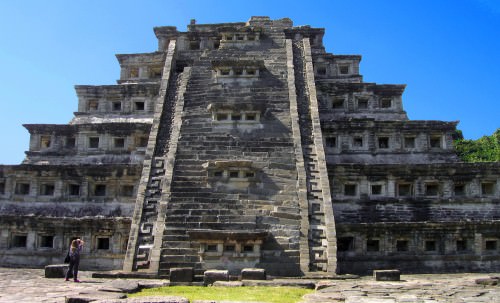
Pyramid of the Niches, El Tajin
TAJIN CHICO
Constructed between the 9th and 10th centuries CE, Tajin Chico was probably used as a residential area for the city's aristocracy. The higher placed the buildings, the newer they are, so that the large three-level platform building on the north-west hill is the most recent, as proven by the presence of older pottery shards in its masonry. Built in the 10th century CE, it originally had a six- column colonnade on its eastern façade and is approached by a short stairway with retaining walls. The columns carry relief carvings which narrate scenes from the life of probably El Tajin's last ruler, 13 Rabbit. Once again, architectural decoration on several Tajin Chico structures often remind of a Maya influence, this time from Uxmal.
BALLCOURTS
There are no fewer than 17 ballcourts at El Tajin, an unusually high number, which has led the historian ME Miller to speculate that the city may well have held great sporting festivals much like those at Olympia in Ancient Greece. Indeed, El Tajin seems to have been a repository for rubber which was used to make the solid black balls used in the Mesoamerican ballgame. Most courts were deliberately positioned so that background topographical rises were framed by the sloping sides as one looked down the length of the court.
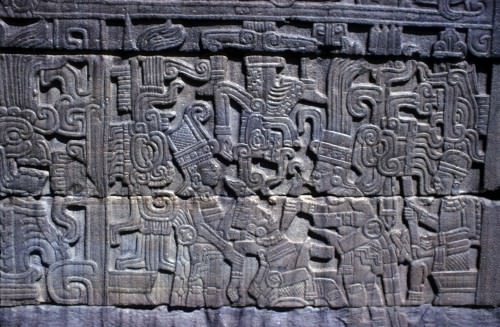
Human Sacrifice, El Tajin
The south ballcourt is of particular interest because of its relief sculpture depicting rituals, including human sacrifice. Dating to between 700 and 900 CE, four of the six relief panels (each composed of several slabs) have a large skeleton figure rising from a pot on their left sides. One panel shows two ball players cutting out the heart of a third player above whom is another skeletal figure hungry for the victim's soul. Another panel shows a warrior ritual with a central figure dressed as an eagle standing over a person reclining on a couch and flanked by two musicians. All the panels have a decorative double frame, a typical feature of Veracruz art.
MAP
Pizarro & the Fall of the Inca Empire › Who Was?
Ancient Civilizations
In 1533 CE the Inca Empire was the largest in the world. It extended across western South America from Quito in the north to Santiago in the south. However, the lack of integration of conquered peoples into that empire, combined with a civil war to claim the Inca throne and a devastating epidemic of European-brought diseases, meant that the Incas were ripe for the taking.Francisco Pizarro arrived in Peru with an astonishingly small force of men whose only interest was treasure. With superior weapons and tactics, and valuable assistance from locals keen to rebel, the Spanish swept away the Incas in little more than a generation. The arrival of the visitors to the New World and consequent collapse of the Inca Empire was the greatest humanitarian disaster to ever befall the Americas.
THE INCA EMPIRE
The Incas themselves called their empire Tawantinsuyo (or Tahuantinsuyu) meaning 'Land of the Four Quarters' or 'The Four Parts Together'. Cuzco, the capital, was considered the navel of the world, and radiating out were highways and sacred sighting lines ( ceques ) to each quarter: Chinchaysuyu (north), Antisuyu (east), Collasuyu (south), and Cuntisuyu (west).Spreading across ancient Ecuador, Peru, northern Chile, Bolivia, upland Argentina, and southern Colombia and stretching 5,500 km (3,400 miles) north to south, a mere 40,000 Incas governed a huge territory with some 10 million subjects speaking over 30 different languages.
The Incas believed they had a divine right to rule over conquered peoples as in their mythology they were brought into existence at Tiwanaku (Tiahuanaco) by the sun god Inti. As a consequence, they regarded themselves as the chosen few, the 'Children of the Sun', and the Inca ruler was Inti's representative and embodiment on earth. In practical terms, this meant that all speakers of the Inca language Quechua (or Runasimi) were given privileged status, and this noble class then dominated all the important political, religious, and administrative roles within the empire.
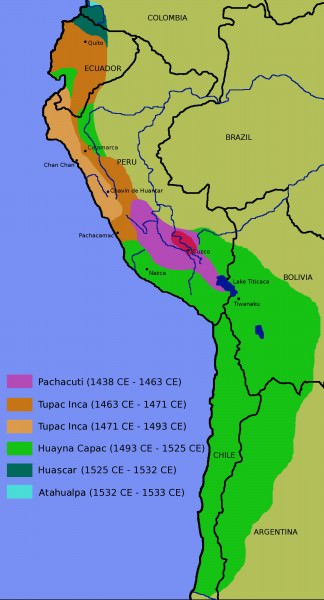
Map of the inca Empire
The rise of the Inca Empire had been spectacularly quick. Although Cuzco had become a significant centre some time at the beginning of the Late Intermediate Period (1000-1400 CE), the process of regional unification only began from the late 14th century CE and significant conquest in the 15th century CE. The Empire was still young when it was to meet its greatest challenge.
PIZARRO & THE CONQUISTADORES
Francisco Pizarro and his partner Diego de Almagro were both in their mid-50s, from humble backgrounds, and neither had won any renown in their native Spain. Adventurers and treasure-seekers, they led a small group of Spanish adventurers eager to find the golden treasures their compatriots had found in the Aztec world of Mexico a decade earlier. Sailing down the Pacific coast from Panama in two small caravel merchant ships, they searched on in Colombia and the Ecuadorian coast but could not find the gold they so desperately sought. This was Pizarro's third such expedition, and it seemed his very last chance for fame and glory.
Then, in 1528 CE, one Bartolomé Ruiz (the expedition's pilot) captured a raft off the coast which was full of treasure. There might, after all, be something worth exploring deeper in South America. Pizarro used the discovery as a means to secure the right from the Spanish king Charles V to be governor of any new territory discovered with the Crown getting its usual one-fifth of any treasure found. With a force of 168 men, which included 138 veterans, 27 cavalry horses, artillery, and one friar, a Father Valverde, Pizarro headed for the Andes.

Francisco Pizarro
In 1531 CE, making slow and careful progress, he reached and conquered Coaque on the Ecuadorian coast and waited for reinforcements. These arrived the following year and swelled the Spanish force to 260 men of which 62 were cavalry. The force moved on down the coast to Tumbes, pillaging as they went and putting the natives to the sword. Moving on again they began to see the tell-tale signs of a prosperous civilization – storehouses and well-built roads. They formed a new settlement at San Miguel (modern Piura), and by the end of the year 1532 CE Pizarro was ready to make first contact with the rulers of what seemed a huge and wealthy empire.
TROUBLE IN THE EMPIRE
When the foreign invaders arrived in Peru the Incas were already beset by some serious internal problems. As we have seen, their massive empire was a politically fragile and loose integration of conquered states whose subservience came from Inca military dominance and the taking of hostages - both of important persons and important religious artefacts - to ensure a continued, if uneasy, compliance to Cuzco's rule. Unpopular taxes were extracted in the form of goods or service (military and general labour), and many communities were forcibly resettled to other parts of the empire or had to welcome new communities of people more loyal to their overlords.
Perhaps more significantly than this unrest, when Pizarro arrived on the scene the Incas were fighting amongst themselves.On the death of the Inca ruler Wayna Qhapaq in 1528 CE, two of his sons, Waskar and Atahualpa, battled in a damaging six-year civil war for control of their father's empire. Atahualpa finally won but the empire was still beset by factions yet to be fully reconciled to his victory.
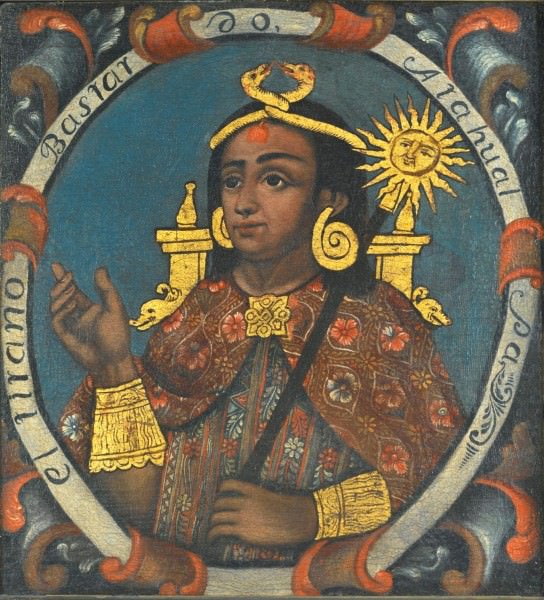
Atahualpa
Finally, if all those factors were not enough to give the Spanish a serious advantage, the Incas were at that time hit by an epidemic of European diseases, such as smallpox, which had spread from central America even faster than the European invaders themselves. Such a disease killed Wayna Qhapaq in 1528 CE and in some places a staggering 65-90% of the population would die from this invisible enemy.
PIZARRO MEETS ATAHUALPA
On Friday, 15th of November, 1532 CE, the Spaniards approached the Inca town of Cajamarca in the highlands of Peru.Pizarro sent word that he wished to meet the Inca king, there enjoying the local springs and basking in his recent victory over Waskar. Atahualpa agreed to finally meet the much-rumoured bearded white men who were known to have been fighting their way from the coast for some time. Confidently surrounded by his 80,000 strong army Atahualpa seems not to have seen any threat from such a small enemy force, and he made Pizarro wait until the next day.
The first formal meeting between Pizarro and Atahualpa involved a few speeches, a drink together while they watched some Spanish horsemanship, and not much else. Both sides went away planning to capture or kill the other party at the first available opportunity. The very next day Pizarro, using the conveniently labyrinth -like architecture of the Inca town to his advantage, set his men in ambush to await Atahualpa's arrival in the main square. When the royal troop arrived, Pizarro fired his small canons, and then his men, wearing armour, attacked on horseback. In the ensuing battle, where firearms were mismatched against spears, arrows, slings, and clubs, 7,000 Incas were killed against zero Spanish losses. Atahualpa was hit a blow on the head and captured alive.
ATAHUALPA'S RANSOM & DEATH
Either held for ransom by Pizarro or even offering a ransom himself, Atahualpa's safe return to his people was promised if a room measuring 6.2 x 4.8 metres were filled with all the treasures the Incas could provide up to a height of 2.5 m. This was done, and the chamber was piled high with gold objects from jewellery to idols. The room was then filled twice again with silver objects. The whole task took eight months, and the value today of the accumulated treasures would have been well over $50 million. Meanwhile, Atahualpa continued to run his empire from captivity, and Pizarro sent exploratory expeditions to Cuzco and Pachacamac while he awaited reinforcements from Panama, enticed by sending a quantity of gold to hint at the wealth on offer. Then, having got his ransom, Pizarro summarily tried and executed Atahualpa anyway, on the 26th of July, 1533 CE. The Inca king was originally sentenced to death by burning at the stake, but after the monarch agreed to be baptised, this was commuted to death by strangulation.
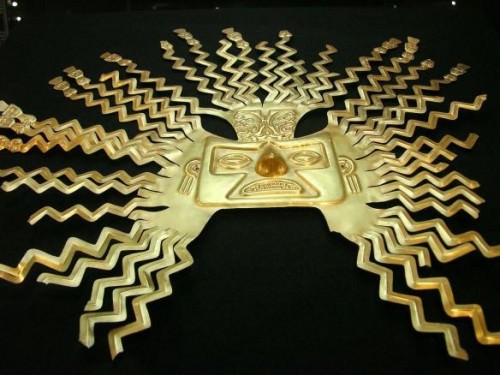
Inca Gold Sun Mask
Some of Pizarro's men thought this was the worst possible response, and Pizarro received criticism from the Spanish king for treating a foreign sovereign so shabbily, but the wily Spanish leader had seen just how subservient the Incas were to their king, even when he was held captive by the enemy. As a living god, Pizarro perhaps knew that only the king's death could bring about the total defeat of the Incas. Indeed, even in death, the Inca king exerted an influence over his people for the severed head of Atahualpa gave birth to the enduring Inkarri legend. For the Incas believed that one day the head would grow a new body and their ruler would return, defeat the Spanish, and restore the natural order of things. Crucially, the period of Atahualpa's captivity had shown the Spanish that there were deep factions in the Inca Empire and these could be exploited to their own advantage.
THE FALL OF CUZCO
Having cut off the snake's head, the Spanish then set about conquering Cuzco with its vast golden treasures which were reported by Hernando Pizarro following his reconnaissance expedition there. After that, they could deal with the rest of the empire. The first battle was with troops loyal to Atahualpa near Hatun Xauxa, but the Spaniards were helped by the local population delighted to see the back of the Incas. The Spaniards were given supplies from the local Inca storehouses, and Pizarro established his new capital there. Local assistance and the plundering of the Inca storehouses would become a familiar pattern which aided Pizarro for the remainder of his conquest.
The invaders next defeated an army in retreat at Vilcaswaman but did not have everything their own way and even suffered a military defeat when an advance force was attacked by surprise on their way to Cuzco. The next day the Old World visitors resumed their unstoppable march, though, and swept all before them. A brief resistance at Cuzco was overcome, and the cityfell into Pizarro's hands with a whimper on 15th of November, 1533 CE. The treasures of the city and the golden wonders of the Coricancha temple were ruthlessly stripped and melted down.
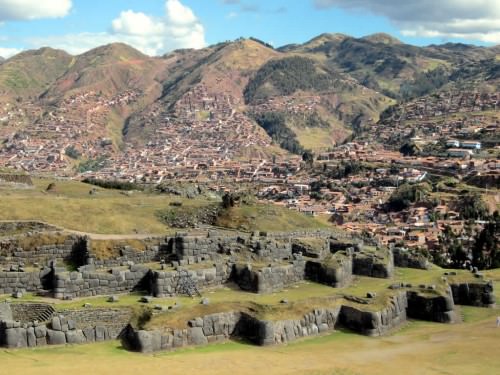
Sacsahuaman
Pizarro's first attempt to install a puppet ruler - Thupa Wallpa, the younger brother of Waskar - failed to restore any sort of political order, and he soon died of illness. A second puppet ruler was installed – Manqo Inka, another son of Wayna Qhapaq.While he ensured the state did not collapse from within, Pizarro and his men left to pacify the rest of the empire and see what other treasures they could find.
CONQUERING THE EMPIRE
The Spanish were severely tested in the northern territories, where armies led by Ruminawi and Quizquiz held out, but these too capitulated from internal strife and their leaders were killed. The Europeans' relentless conquest could not be answered. In this, they were greatly helped by the Inca mode of warfare which was highly ritualised. Such tactics as deceit, ambush, and subterfuge were unknown to them in warfare, as were changing tactics mid-battle and seizing opportunities of weakness in the enemy as they arose. In addition, Inca warriors were highly dependent on their officers, and if these conspicuous individuals fell in battle, a whole army could quickly collapse in panicked retreat. These factors and the superior weaponry of the Europeans meant the Incas had very little chance of defending a huge empire already difficult to manage. The Incas did quickly learn to fight back and deal with cavalry, for example by flooding areas under attack or fighting on rough terrain, but their spears, slings, and clubs could not match bullets, crossbows, swords, and steel armour. The Spaniards also had nearly half the population of the old empire fighting for them as old rivalries and factions re-emerged.
The Spanish soon found out that the vast geographical spread of their new empire and its inherent difficulties in communication and control (even if their predecessors had built an excellent road system) meant that they faced the same management problems as the Incas. Rebellions and defections spread all over, and even Manqo Inka rebelled and formed his own army to try and win real power for himself. Cuzco and the new Spanish stronghold of Cuidad de Los Reyes (Lima) were besieged by two huge Inca armies, but the Spaniards held out until the attackers had to retreat. The Inca armies were largely composed of farmers, and they could not abandon their harvest without starving their communities. The siege was raised again the next year, but once more the Spanish resisted, and when they killed the army leaders in a deliberately targeted attack, resistance to the new order ebbed away. Manqo Inka was forced to flee south where he set up an Inca enclave at Vilcabamba. He and his successors would resist for another four decades. Finally, in 1572 CE, a Spanish force led by Viceroy Toledo captured the Inca king Thupa Amaru, took him back to Cuzco, and executed him. The last Inca ruler was gone and with him any hope of restoring their once great empire.

Inca Road Rest Station
CONCLUSION
Atahualpa, following victory in the war with his brother, had killed historians and destroyed the Inca quipu records in what was intended to be a total renewal, what the Incas called a pachakuti or 'turning over of time and space', an epoch-changing event which the Incas believed periodically occurred through the ages. How ironic then, that Atahualpa was to suffer a pachakutihimself and the new rulers would similarly loot, burn, and destroy every vestige of Andean culture they could find. The arrival of the Old World into the New turned it upside down. Nothing would ever be the same again.
The Spanish, after decades of their own internal problems, which included the murder of Pizarro, eventually established a stable colonial government in 1554 CE. For the Andean people, their way of life, which had stretched back millennia despite the Inca interruption, would be challenged again by the new epoch. These were the lucky ones, though, as by 1570 CE 50% of the pre-Columbian Andean population had been wiped out. For those ordinary people who survived the ravages of war and disease, there was to be no respite from a rapacious overlord once again eager to steal their wealth and impose on them a foreign religion.
LICENSE:
Article based on information obtained from these sources:with permission from the Website Ancient History Encyclopedia
Content is available under License Creative Commons: Attribution-NonCommercial-ShareAlike 3.0 Unported. CC-BY-NC-SA License